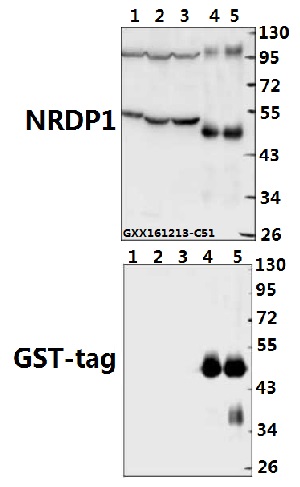Product Name :
NRDP1 (E119) polyclonal antibody Background :
The RING-type zinc finger motif is present in a number of viral and eukaryotic proteins and is made of a conserved cysteine-rich domain that is able to bind two zinc atoms. Proteins that contain this conserved domain are generally involved in the ubiquitination pathway of protein degradation. Nrdp1, also known as RNF41 (RING finger protein 41), SBBI03 or FLRF, is a 317 amino acid protein that contains one RING-type zinc finger and one SIAH-type zinc finger. Expressed in testis, ovary and prostate, Nrdp1 functions as an E3 ubiquitin-protein ligase that, characteristic of E3 ligase proteins, accepts ubiquitin (in the form of a thioester) from an E2 ubiquitin-conjugating enzyme and transfers that ubiquitin residue to substrates targeted for degradation. Specifically, Nrdp1 interacts with ErbB-3 and UBPY, thereby targeting them for proteasomal degradation. Product :
Rabbit IgG, 1mg/ml in PBS with 0.02% sodium azide, 50% glycerol, pH7.2 Storage&Stability :
Store at 4°C short term. Aliquot and store at -20°C long term. Avoid freeze-thaw cycles. Specificity :
NRDP1 (E119) polyclonal antibody detects endogenous levels of NRDP1 protein. Immunogen :
Synthetic peptide, corresponding to amino acids 100-150 of Human NRDP1. Conjugate :
Unconjugated Modification :
Unmodification
NRDP1 (E119) polyclonal antibody Background :
The RING-type zinc finger motif is present in a number of viral and eukaryotic proteins and is made of a conserved cysteine-rich domain that is able to bind two zinc atoms. Proteins that contain this conserved domain are generally involved in the ubiquitination pathway of protein degradation. Nrdp1, also known as RNF41 (RING finger protein 41), SBBI03 or FLRF, is a 317 amino acid protein that contains one RING-type zinc finger and one SIAH-type zinc finger. Expressed in testis, ovary and prostate, Nrdp1 functions as an E3 ubiquitin-protein ligase that, characteristic of E3 ligase proteins, accepts ubiquitin (in the form of a thioester) from an E2 ubiquitin-conjugating enzyme and transfers that ubiquitin residue to substrates targeted for degradation. Specifically, Nrdp1 interacts with ErbB-3 and UBPY, thereby targeting them for proteasomal degradation. Product :
Rabbit IgG, 1mg/ml in PBS with 0.02% sodium azide, 50% glycerol, pH7.2 Storage&Stability :
Store at 4°C short term. Aliquot and store at -20°C long term. Avoid freeze-thaw cycles. Specificity :
NRDP1 (E119) polyclonal antibody detects endogenous levels of NRDP1 protein. Immunogen :
Synthetic peptide, corresponding to amino acids 100-150 of Human NRDP1. Conjugate :
Unconjugated Modification :
Unmodification
-
 Western blot (WB) analysis of NRDP1 (E119) polyclonal antibody at 1:500 dilution Lane1:H9C2 whole cell lysate(40ug) Lane2:HCT116 whole cell lysate(40ug) Lane3:A549 whole cell lysate(40ug) Lane4:NRDP1 recombinant protein(100ng) Lane5:NRDP1 recombinant protein(200ng)
Western blot (WB) analysis of NRDP1 (E119) polyclonal antibody at 1:500 dilution Lane1:H9C2 whole cell lysate(40ug) Lane2:HCT116 whole cell lysate(40ug) Lane3:A549 whole cell lysate(40ug) Lane4:NRDP1 recombinant protein(100ng) Lane5:NRDP1 recombinant protein(200ng)
Bioworld Biotech only provide peptides for our antibodies and do not provide additional peptide customization services.
Price/Size :
USD 368/1mg/vial
Tips:
For phospho antibody, we provide phospho peptide(0.5mg) and non-phospho peptide(0.5mg).Describe :
Blocking peptides are peptides that bind specifically to the target antibody and block antibody binding. These peptide usually contains the epitope recognized by the antibody. Antibodies bound to the blocking peptide no longer bind to the epitope on the target protein. This mechanism is useful when non-specific binding is an issue, for example, in Western blotting (WB) and Immunohistochemistry (IHC). By comparing the staining from the blocked antibody versus the antibody alone, one can see which staining is specific; Specific binding will be absent from the western blot or IHC performed with the neutralized antibody.Formula:
Synthetic peptide was lyophilized with 100% acetonitrile and is supplied as a powder. Reconstitute with 0.1 ml DI water for a final concentration of 10 mg/ml.The purity is >90%,tested by HPLC and MS.
Storage:
The freeze-dried powder is more stable. For short time at 2-8°C. For long term storage store at -20°C.
Note :
This product is for research use only (RUO only). Not for use in diagnostic or therapeutic procedures.
 NRDP1 (E119) polyclonal antibody
NRDP1 (E119) polyclonal antibody  Datasheet
Datasheet COA
COA MSDS
MSDS SHIP
SHIP